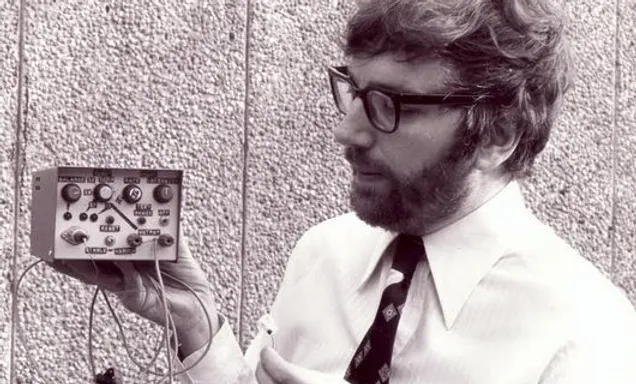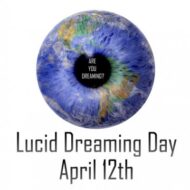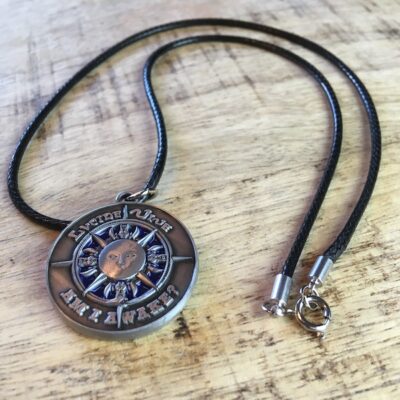Lucid Dreaming Day commemorates the date that dream research pioneer Dr. Keith Hearne successfully had a lucid dreamer communicate to the outside world that he was dreaming (while firmly in a dream state).
That date: April 12, 1975.
A Brief History of the Scientific Validation of Lucid Dreaming
Keith Hearne’s dissertation on lucid dreaming at the University of Liverpool was published in 1978. He presented the topic at several academic meeting halls as early as 1977.

In Hearne’s pioneering lucid dreaming study, brain activity during sleep was measured via EEG and correlated with the experience of lucid dreaming via specific predetermined eye moments that served as signals (EOG) that the subjects were making volitional choices while asleep. The lucid dreamer who sent the eye signals was no other than Alan Worsley, who has since gone on to perform over 50 signal-verified lucid dreams in the lab.
However, Hearne was not able to find a peer reviewed mainstream science journal to publish his findings.
 Meanwhile, apparently unaware of Hearne’s work, Stephen LaBerge and his colleagues in the United States used a similar laboratory method, and, in 1980, published their results in the journal Perceptual and Motor Skills. LaBerge’s work on this topic cannot be overstated, as his publications got worldwide attention, especially a 1982 article in Omni Magazine titled “Design your dreams.”
Meanwhile, apparently unaware of Hearne’s work, Stephen LaBerge and his colleagues in the United States used a similar laboratory method, and, in 1980, published their results in the journal Perceptual and Motor Skills. LaBerge’s work on this topic cannot be overstated, as his publications got worldwide attention, especially a 1982 article in Omni Magazine titled “Design your dreams.”
Also, a third group of researchers, led by Robert Olgivie and Harry Hunt, independently isolated lucidity in the REM sleep during this same time period.
All together, these pioneering studies confirmed that lucid dreaming is not some kind of “micro-awakening,” but rather an actual state of mind capable of reflective thought.
Many other researchers continued mapping out the psychological, cultural and spiritual aspects of lucid dreaming, such as Jayne Gackenbach, Peter Fenwick, George Gillespie, Scott Sparrow, and Patricia Garfield. And many, many more.
So while the date chosen for Lucid Dreaming Day is a respectful nod to the creative first that Keith Hearne achieved, in a grander sense the event is a celebration of all the creative potentials inherent in lucid dreams.
Thanks go to lucid dream educator Daniel Love, author of Are you Dreaming?, for founding this celebration back in 2014 and continuing to spread the good news of lucid dreaming with his YouTube channel.
Enter my drawing to win a free Lucid Amulet!
 Subscribe to Dream Studies Portal (if you haven’t already) and then
Subscribe to Dream Studies Portal (if you haven’t already) and then- Enter a comment below about your favorite method for triggering lucid dreams.
I’ll randomly choose (ie engage in some light chaos divination) the winning commenter/subscriber, and send you the Lucid Amulet for free. This beautiful and mysterious object can be worn as a pendant or work like a dream catcher — reminding you to perform reality checks and ask… Are you dreaming?
The contest is open for the next 3 days, though April 16th.
Nerd corner
Hearne, K. (1978). Lucid dreams: electrophysiological and psychological study. Doctoral dissertation: Liverpool University.
LaBerge, S., Nagel, L., Dement, W., Zarcone, V., (1981). Lucid dreaming verified by volitional communication during REM sleep. Perceptual and Motor Skills, 1980, 51, 1039–1042. (c).
Olgilvie, R, Hunt, H., Tyson, P., Lucescu, M., Jenkins, D. (1978). Searching for lucid dreams. Sleep Research, 7: 165.
My favorite way to induce lucid dreaming is by gunning for an Out of the Body Experience (OBE). My current method involves medication to “hemi sync” music. This is the “second to last meditation”. The final meditation occurs prior to sleep. Both meditations are in the laying down position.
This method improves the chances of having a lucid dream in the beginning of the night. As more hours are clocked in, another method that could be used is the “Awake Back to Sleep” method. The result is not always immediate; however the dreams get better. The first dream is usually a vivid dream, followed by a short waking period, followed by a lucid dream, followed by a short waking period, followed by an OBE.
There’s no need to do any “reality tests” in the OBE, as the vibrations that are experienced in the beginning, followed by a departure from the physical, followed by a floating sensation form the “instant reality check”.
I read Robert Monroe’s “Journeys Out of the Body,” back in the 1980s in high school, and was able to induce spontaneous OBEs on a regular basis. As I got older, the instances went down, but still occurred occasionally. I reread the book this year, along with the other two books in Monroe’s “Journeys Trilogy.”
I recently obtained the Gateway Experience program from the Monroe Institute and it has done wonders in the sleep and dreaming department. The number of lucid dreams that “spontaneously occur” have started to occur more frequently than before. If OBEs are the stars, then lucid dreaming is the moon. Aim for the stars.
Hi Ryan. Great article. My favorite way to induce a lucid dream is Laberge’s MILD (visualization) method. Hope to meet you at IASD in Ashland if you are going.
i have always had an interest in dreams and have used them to influence change in my waking life. I am back keeping a dream journal again but I wake up remembering dreams whether I keep writing things down or not. I do remember them better when I do write and my writing has been so helpful in reminding me of things. I have enjoyed reading Edgar Cayce, Carlos Castaneda, Rosicrucian texts and have learned much over the years through Robert Moss. Now I am delighted to have an opportunity to see what you share! Thanks for the sample download!
Really like this article. My lucid dreams so far happened more often when I read books related to this topic, drift into sleep with the intention to get lucid and put also throughout the day to being / getting lucid. Which so often results in questioning everything during the day, if this is a dream, illusion or not 😉 And I love to dive deeper and deeper in all those topics. Actually this changed so much in my life….
I’ve been fascinated with lucid dreaming for 4 months now. In the first month I had 3 lucid dreams but since then it hasn’t occurred anymore. I would love to do it more to explore the endless opportunities for (self)exploration.
Kim – The Netherlands
I cannot induce a lucid dream, but whenever my dreams take a turn for the bizarre (e.g. a nightmare, a dream I’ve had before, a place that’s supposed to be real but isn’t) it makes me realize that I’m dreaming. If it’s a nightmare I’m usually being chased so I turn around and confront the ‘monster”. Otherwise, I want to fly and meet up with people. If I fly, I usually can’t stay lucid, I get pulled back into dreaming again. When I try to meet up with other people the challenge is finding them, I get close, i sometimes see them, but I can never get them to wake up in their dream and talk to me.
My favorite lucid dream induction technique is WBTB combined with galantamine and sometimes L-DOPA. This combination gives me the greatest odds of getting lucid
My favorite method of triggering lucid dreams is not one single thing, but many things that accompany eachother. However, if I had to choose just one thing, it would be dream recall. Dream recall allows us to recognize patterns in the dreams we’ve had, then associating the recognized patterns of experience in the dream-state with waking life. For me, this builds a bridge between the two states. There are multiple “bridges” that can be built for the sake of inducing lucid dreams, but this is the most important one in my opinion because it trains the brain to think of everything we experience, even in waking life, as a dream. Recalling dreams from the previous night in a relaxed state just before bed is a powerful way to set intention to remember dreams subconsciously, this paired with a wake-back-to-bed technique almost guarantees lucid dreams for me.
My favorite way of inducing a lucid dream is to do my best to stay conscious as I fall asleep. It’s not difficult, exactly, because it is rare. But when it happens, it seems to be more stable than other times I lucid dream.
The way I induced my first OBE in certainly unusual. I went to bed thinking about a very scary movie I had watched the hour before. I was under the blanket, except for one arm left out on top of the blanket. As I thought about the movie and started feeling really scared, that arm on top of the blanket started having really weird sensations I can’t describe. That was so strange, I tried it again each night for about 10 nights; and each time, the bizarre feelings in that arm would start up again.
What I didn’t know was that the strange feeling was my astral arm, rising out of my physical arm and placing itself safely under the blanket with the rest of me. Also unknown to me, was that repeating this process each night at bedtime was loosening the attachment of my astral body to my physical body. So eventually, it wasn’t just my astral arm that moved out of the physical. Instead, my entire astral body slipped out and moved away from the bed, taking my consciousness with it! I was floating out in the room, fully aware that I’d life my body behind!
Lately I get lucid through body awareness. I am meditating more during the day, and this self regulation allows me to feel more the subtlety of the dream state. Still long way to go! Thank you for all tour brilliant work!